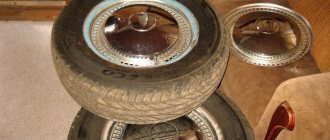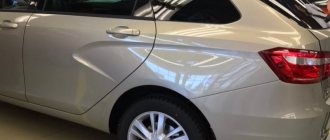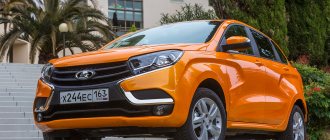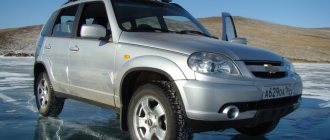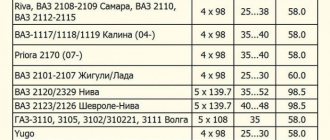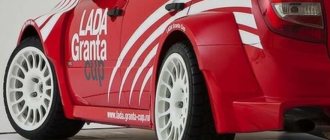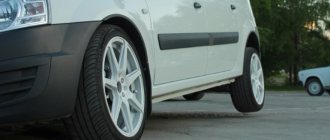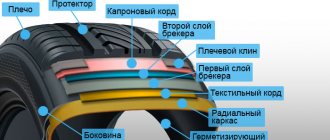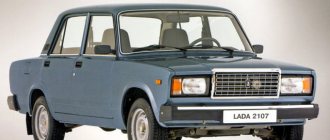Buy alloy wheels in the online store in stock and on order.
Car owners may be faced with a situation where an outwardly similar wheel from another car cannot be installed on the hub. The diameter of the central hole (CO) is too small. And, in other cases, the CO can be much larger than necessary. Both types of discrepancy are undesirable. To eliminate discrepancies, when choosing wheels, you should be guided by such a parameter as disk DIA. What is this technical standard, where to look for it, what does it affect and how to choose the right wheel to the hub? You will learn about this from our material.
DIA: what does it mean when choosing disks
When it comes to purchasing new components, it is quite difficult to do without expert advice. When choosing designs for their car, many are not even familiar with the basic parameters. Therefore, before installing components on your car, you need to study all the vehicle indicators specified in the technical passport of the manufacturer.
DIA value
Their list primarily includes stem, PCD, DIA, product width, etc. Wheel marking plays an important role. Its indicator is usually indicated on the label or in the technical data sheet. This information is displayed for all types of structures in a standard format.
Before correctly reading the marking, the car owner must understand what a certain term may mean:
- A is the diameter of the central hole of the disk;
- B - width;
- ET - the offset of the structure is used to determine the distance between the space where the rim is applied to the hub and the internal sphere of the structure.
Important!
The mating plane is the base that connects the wheel rim to the vehicle hub. When choosing designs, you should not be guided only by the external data of the components. Otherwise, you can worsen the technical condition of the vehicle, as well as its handling on smooth asphalt or off-road.
Disc overhang is divided into positive, negative and zero. In the latter option, the mating plane of the product is determined between the middle of the structure. If they coincide with each other, then the wheel type is considered zero.
Sometimes it happens that the overhang indicator is smaller, then the structure will stick out unsightly from the outside of the vehicle. However, some motorists like wide components. Therefore, they choose the first option. In the second case, everything looks different: the higher the ET value, the tighter the structure fits inside the car.
Note!
The width of the structure may differ from the disc offset value. Many manufacturers of automotive components indicate in the technical data sheet for the car that wheels with a larger width have a lower offset indicator.
PCD means the circle diameter of the wheel rim holes. This indicator determines the location of the wheel design mounting holes.
You might be interested in this About wheel bolt patterns on Mitsubishi Lancer
Often, beginners and even experienced drivers cannot decipher the symbols indicated on car wheels. To avoid mistakes when choosing tires, you need to carefully study all the indicators. What is DIA on disks is the diameter of the central hole. On many manufactured alloy wheels, in order to give the car a presentable appearance, the diameter of the central hole DIA is made large. To correctly select the size of a car hub, experts recommend choosing an adapter ring or bushing.
What is Wheel Rim DIA
DIA is the size of the central hole (CO) of the wheel rim. Despite its apparent simplicity, a lot depends on the size of this parameter. The diameter of the central heating center on different brands of cars may differ, since the car is designed for certain performance characteristics. That is, the parameters of one machine may differ significantly from the parameters of another.
The wheel is the main element of a vehicle. Therefore, its design features can also be different, providing the car with factory characteristics. The DIA parameter may sometimes be designated by the letter “D”. It can be found in the operating instructions, in the “Technical Specifications” table, section “Wheels”.
Also, it is applied to the disk itself, along with other parameters. For example, 4*108/6J/DIA 63.3/R15. If there is no information, you will have to use a caliper and measure the diameter of the central center yourself. For all discs, the diameter is indicated in mm.
Sometimes the same wheels are produced for different car models. For example, on a VAZ-1117/1118/1119 Kalina (04-), with a standard bolt pattern of 4×98, the DIA parameter is 58 mm, and for a VAZ 2101-2107 Zhiguli/Lada with the same bolt pattern 4×98, the DIA is 60 mm.
Design mounting hole
Product mounting hole
The mounting diameter of the wheel rim is as follows - 7.5 j x16 H2 5/112 ET 35 d 66.6:
- 7.5 is the width of the structure.
- J is a feature of automotive designs.
- x is the inseparability of the wheels.
- 16 — landing diameter.
- H2 - two protrusions.
- 5/112 is determined by the number of mounting holes for bolts or nuts, and 112 serves as the diameter of the circle.
- ET 35 - product size is 35 mm.
- d 66.6 - diameter of the central hole.
Tire and wheel sizes part 1. Marking and selection of car rims.
Marking and selection of car rims. A striking example of how easily different measurement systems can coexist and how deeply this confusion has entered our lives.
| Example of disk marking: 6.5J×15 H2 5/112 ET39 d57.1 |
- Number and bore diameter of the location of the wheel rim mounting holes. - fastening to the car
- Disc central hole, hub diameter. — fastening to the car
- Wheel rim width. — fastening to the tire (tire)
- Wheel rim diameter. — fastening to the tire (tire)
- Wheel offset. Wheel removal. - wheelbase width
- Disc rim flanges, side flanges. — fastening to the tire (tire)
- Rim shelves and bumpers. - fastening to the tire (tire)
- Other possible designations.
- Wheel mount. The procedure for tightening bolts (nuts).
- Recommended tightening torque depending on the wheel thread diameter
You can familiarize yourself with the decoding of tire designations here.
The number and mounting diameter of the location of the wheel rim mounting holes.
6.5J×15 H2 5/112 ET39 d57.1 - “five holes with a diameter of 112 mm”
| ||
| 3 holes | 4 holes | 5 holes |
To independently determine PCD = diameter “B” in Fig. necessary:
| ||
Disc central hole, hub diameter.
6.5J×15 H2 5/112 ET39 d57.1 - “hole for hub 57.1 mm”
| d 57.1 - Diameter of the centering hole on the disk. Must exactly match the diameter of the landing cylinder on the hub. Often the same wheel (wheel rim) is offered for cars from different companies, so the central hole in the wheel rim must be different. Because in addition to the centering function, the landing cylinder has another, no less important one - it partially takes on the load that falls on the mounting bolts (studs). Therefore, if the centering hole of the disk you like is larger than the hub mounting cylinder, you will have to use special centering rings, which can be bought at tire centers, or ordered somewhere. The external and internal dimensions of the centering ring must correspond exactly to the diameters of the hub cylinder and the centering hole of the disk, respectively. |
Wheel rim width.
A disc wheel consists of two main parts: the rim and the disc itself. The disc is the central part of the wheel, with which the wheel is attached to the car hub with bolts or nuts. The rim is a cylindrical part of a wheel with a special profile, which is located perpendicular to the disk and serves to mount a rubber tire on it.
6.5J×15 H2 5/112 ET39 d57.1 - “disc (rim) seat width 6.5 inches”
| 6.5 is the seating (!not overall!) width of the disk rim in inches (sometimes the value of the disk width in the marking is indicated as a fraction 6 1/2). The width is measured not along the outer sides of the rim, from edge to edge, but along the so-called “disc shelf”, on which the sidewalls of the tire rest. The width of the rim and tire must strictly correspond to each other so that the tires, after installation on the rims, have the optimal shape specified by the manufacturer. DIMENSIONS: are always given in inches (1 inch = 25.4 mm), except for designs, which will give dimensions in millimeters. |
Wheel rim diameter.
6.5J×15 H2 5/112 ET39 d57.1 - “wheel diameter (size) 15 inches”
15 – landing (!not overall!) diameter of the wheel rim in inches, which must correspond to the landing diameter of the tire. Passenger cars use wheels with a diameter of 12 to 32 inches, the most common diameters being 14-16 inches. 1 inch=25.4 mm.
Wheel offset. Wheel removal.
6.5J×15 H2 5/112 ET39 d57.1 - “positive wheel offset 39 mm”
| ET=39 — Disc offset or offset in mm (this parameter may also be marked OFFSET and DEPORT). Usually it can be 10 mm less than the standard without any problems and usually depends on the width of the rim. The smaller the offset, the wider the wheelbase. Disk offset is the distance between the mounting plane of the wheel (the plane of which the disk is pressed against the hub) and the middle of the disk width (an imaginary plane passing through the middle of the rim). To determine the wheel offset, you need to measure dimension “B” on the inside of the wheel. Divide size “X” in half. Subtract size X/2 from size “B”. If the difference is positive, then the offset is positive; if it is negative, then the offset is “negative”. Or, in other words: The offset is “positive” if the mating plane does not go beyond the imaginary plane. The offset is “negative” if the mating plane passes through an imaginary plane. | ||
Disc rim flanges, side flanges.
6.5J×15 H2 5/112 ET39 d57.1 - “type J rim flange”
J (JJ, JK, K,B, P, D...) This letter encodes technical information about the disc rim flanges (design, shape, height). The most common types of disks today are J (mainly for single-wheel drive vehicles), and JJ (usually for all-wheel drive). The flanges of the rim of the rim affect the installation of rubber, compensating weights, as well as the resistance to displacement of the tire on the rim in extreme conditions. Obviously, despite the external interchangeability of, for example, J and JJ disks, it is still better to choose the parameter recommended by the car manufacturer.
Wheel rim and champa shelves.
6.5J×15 H2 5/112 ET39 d57.1 - “shelves rims and humps type H2”
H (H2, FH, AH, CH...) – these letters encrypt information about the design features of the disk rim flanges and the protrusions (hamps) on them. Humps are designed for tubeless tires and ensure correct installation of the tire on the rim. Some tires require special wheel parameters in this regard; this point needs to be clarified when purchasing tires. In general, a car enthusiast does not need to delve deeply into the essence of these designations.
Other possible designations.
The disk may also indicate:
- Date of manufacture . Usually a year and a week. For example: 0504 means the disc was released in week 5 of 2004.
- SAE, ISO, TUV, PCT... - the mark of the regulatory body. The marking indicates that the wheels comply with international rules or standards.
- MAX LOAD 2000lb - a very common designation for the maximum load on a wheel (denoted in units of mass - kilograms or pounds). The maximum load listed here is 2000 lbs (908 kg).
- MAX PSI 50 COLD - means that the tire pressure should not exceed 50 psi (3.5 kgf / sq. cm), the word COLD (cold) means that the pressure should be measured when the tire is cold.
- Other
Wheel mount. The procedure for tightening bolts (nuts).
When installing the wheel, tighten the fastening elements in the order shown in the diagram:
| 4 holes | 5 holes | 6 holes |
Recommended tightening torque depending on the diameter of the wheel mounting thread:
| 10 mm | 60 Nm | 6 kg*m |
| 12 mm | 90 Nm | 9 kg*m |
| 14 mm | 110 Nm | 11 kg*m |
| 7/16 inches | 80 Nm | 8 kg*m |
| 1/2 inch | 90 Nm | 9 kg*m |
Rubber wheel for a passenger car. Matching rubber tires or wheels for one car model.
Is it possible to install components with a large central hole?
Is it possible to install designs with a large CO?
The question of what effect CO has on car rims remains relevant both among beginners and experienced drivers. The disc, which has a universal central diameter, is sold in all stores, as well as online resources. Modern designs that have a large central hole fit many models.
The main reason why original automobile developments are noticeably more expensive than even the highest quality non-original analogs is the requirements of automakers.
What to do if the central hole of the disk is larger than the diameter of the hub?
All wheel sellers recommend testing them in a car before purchasing, and it is advisable to drive them at least a short distance. It's even better to accelerate to a speed of 60-80 km/h to understand exactly how the new wheels behave. It is difficult to install wheels with a central diameter smaller than the hub diameter on a car. Is it possible to install wheels with a larger diameter? Of course, it is best to choose a hole that is ideal for your car. If this is not possible, then you can install a so-called universal disk, with a large central hole. To do this, you need to purchase a set of adapter rings that will compensate for the difference between the hub and the disk. Make sure that they are not damaged during tire installation and that they are always put back after seasonal tire changes. When trying on disks, do not forget to check whether there are any rings left on the hub from previous disks.
What is a central heating center on car wheels?
What does CO mean?
Many people are interested in the question of what the central hole of the disk is. This indicator determines many parameters. The vehicle's handling on icy/wet asphalt depends on this value. When choosing wheels for a car, DIA is defined as a characteristic of the wheel. Sometimes manufacturers may designate this indicator as D. Some car owners buy large mounting bolts that are not installed on the structure. All these nuances should be taken into account to ensure the safety of the driver/passenger.
American tire markings
American tire manufacturers have their own markings. There are two types of markings: The first is very similar to the European one, only the letters “ P ” (Passanger - for a passenger car) or “ LT ” (Light Truck) are placed in front of the standard size. For example: P 195/55 R 14 or LT 235/65 R 15. And other markings, which are fundamentally different from the European ones. For example: 31x10.5 R15 31 - outer diameter of the tire in inches. 10.5 - tire width in inches. 3 R - radial tire. 15 is the inner diameter of the tire in inches. Additional designations used by tire manufacturers
- M&S (Mud + Snow - mud plus snow). This means that these tires are specifically designed as winter or all-season tires.
- M/T (Mud Terrain) - mud landscapes.
- A/T (All Terrain) - all-season tires.
- AS - All Season - all-season
- Any Season is an all-season tire.
- R+W (Road + Winter) - all-season tire.
- All Season is an all-season tire designed for year-round use.
- Rotation - sports tires with a directional tread pattern have an arrow on the sidewall of the tire indicating the required direction of rotation of the tire.
- Outside and Inside (or Side Facing Out and Side Facing Inwards ) are asymmetrical tires, when installing which you must strictly follow the rule for installing the tire on the rim. The inscription Outside (outside) should be on the outside of the car, and Inside (inside) - on the inside.
- Left or Right - means that the tires of this model are left and right. When installing them, you must strictly follow the rule for installing the tire on the car: left ones only on the left, and right ones, accordingly, only on the right.
- Steel Radial - radial tire with metal cord
- Tubeless (TL) - tubeless tire. If this inscription is not present, then the tire can only be used with a tube.
- Tube Type (TT)—the tire must be used with a tube.
- MAX PRESSURE - maximum permissible tire pressure, in kPa.
- RAIN , WATER , AQUA (or umbrella pictogram) - means that these tires are specially designed for rainy weather and have a high degree of protection against aquaplaning.
- Treadwear 380 - wear resistance coefficient, determined in relation to the “base tire”, for which it is equal to 100. The wear indicator is a theoretical value and cannot be directly related to the practical life of the tire, which is significantly influenced by road conditions, driving style, compliance pressure recommendations, adjusting car wheel alignment angles and wheel rotation. The wear indicator is presented as a number from 60 to 620 with an interval of 20 units. The higher its value, the longer the protector will withstand when tested according to the established methodology.
- Traction A - coefficient of adhesion, has values A, B, C. Coefficient A has the largest amount of adhesion in its class.
- Max Load - maximum load and then the values are in kilograms and pounds.
- PR (Ply Rating) - the strength (bearing capacity) of the frame is conditionally assessed by the so-called ply rate. The stronger the carcass, the more air pressure the tire can withstand and, therefore, have a greater load capacity. For passenger cars, tires with a ply rating of 4PR and sometimes 6PR are used, and in this case the latter are labeled “Reinforced”, i.e. “reinforced” (tires with increased load capacity).
- Extra Load (XL) - increased load index.
- Reinforced (Reinf or RF) - increased load index.
- On light trucks and minibuses, the most common tires are 6PR and 8PR. The increased ply (i.e. strength) of the tire can be indicated by the letter “ C ” (commercial), which is placed after the designation of the bore diameter (for example, 185R14C)
- TWI - the sign is located on the sidewall of the tire and shows the location of the remaining tread height marks in the main grooves. For the countries of the European Union and the Russian Federation, the remaining tread height of a worn passenger tire must be at least 1.6 mm.
- ZP - zero pressure (Zéro Pression), Michelin's commercial designation for tires with reinforced sidewalls. ZP: Possibility to continue driving in case of a puncture for a distance of up to 80 km at a speed of up to 80 km/h. ZP SR: Possibility to continue driving in case of a puncture for a distance of up to 30 km at speeds of up to 80 km/h.
- SST - Self Supporting Tires. These tires can carry the load and continue driving after a puncture.
- Dunlop MFS (Maximum Flange Sheild) - The Maximum Bead Rim Protection system protects expensive wheels from damage to curbs and sidewalks - a rubber profile around the circumference of the tire, located on the lower part of the wall above the rim flange, forms a buffer zone.
- Studless - does not suit the studded fabric.
- Studdable - subject to studding. In addition, quality standards are indicated on the tires (the letter “E” in a circle is the European standard, “DOT” is the American standard).
Table of correspondence between tire size and rim width and diameter
| For passenger cars | ||
| Disc diameter (inches) | Tire size | Rim width (inches) |
| Profile height 80 | ||
| 13 | 135/80R13 | 3,5 |
| 145/80R13 | 4 | |
| 155/80R13 | 4,5 | |
| 165/80R13 | 4,5 | |
| 165R13 | 5 | |
| 14 | 175/80R14 | 5 |
| 185/80R14 | 5 | |
| Profile height 70 | ||
| 13 | 135/70R13 | 4 |
| 145/70R13 | 4,5 | |
| 155/70R13 | 4,5 | |
| 165/70R13 | 5 | |
| 175/70R13 | 5 | |
| 185/70R13 | 5,5 | |
| 14 | 165/70R14 | 5 |
| 175/70R14 | 5 | |
| 185/70R14 | 5,5 | |
| 195/70R14 | 6 | |
| Profile height 65 | ||
| 13 | 155/65R13 | 4,5 |
| 165/65R13 | 5 | |
| 175/65R13 | 5 | |
| 14 | 155/65R14 | 4,5 |
| 165/65R14 | 5 | |
| 175/65R14 | 5 | |
| 185/65R14 | 5,5 | |
| 195/65R14 | 6 | |
| 15 | 145/65R15 | 4,5 |
| 155/65R15 | 4,5 | |
| 165/65R15 | 5 | |
| 175/65R15 | 5 | |
| 185/65R15 | 5,5 | |
| 195/65R15 | 6 | |
| 205/65R15 | 6 | |
| 215/65R15 | 6,5 | |
| 16 | 215/65R16 | 6,5 |
| 17 | 235/65R17 | 7 |
| 18 | 235/65R18 | 7 |
| Profile height 60 | ||
| 14 | 165/60R14 | 5 |
| 175/60R14 | 5 | |
| 185/60R14 | 5,5 | |
| 195/60R14 | 6 | |
| 15 | 175/60R15 | 5 |
| 185/60R15 | 5,5 | |
| 195/60R15 | 6 | |
| 205/60R15 | 6 | |
| 225/60R15 | 6,5 | |
| 16 | 205/60R16 | 6 |
| 215/60R16 | 6,5 | |
| 225/60R16 | 6,5 | |
| 235/60R16 | 7 | |
| 17 | 225/60R17 | 6,5 |
| Profile height 55 | ||
| 14 | 185/55R14 | 6 |
| 15 | 175/55R15 | 5,5 |
| 185/55R15 | 6 | |
| 195/55R15 | 6 | |
| 205/55R15 | 6,5 | |
| 225/55R15 | 7 | |
| 16 | 195/55R16 | 6 |
| 205/55R16 | 6,5 | |
| 215/55R16 | 7 | |
| 225/55R16 | 7 | |
| 245/55R16 | 7,5 | |
| 17 | 205/55R17 | 6,5 |
| 215/55R17 | 7 | |
| 225/55R17 | 7 | |
| 235/55R17 | 7,5 | |
| 245/55R17 | 7,5 | |
| 255/55R17 | 8 | |
| Profile height 50 | ||
| 15 | 195/50R15 | 6 |
| 205/50R15 | 6,5 | |
| 225/50R15 | 7 | |
| 16 | 185/50R16 | 6 |
| 195/50R16 | 6 | |
| 205/50R16 | 6,5 | |
| 215/50R16 | 7 | |
| 225/50R16 | 7 | |
| 235/50R16 | 7,5 | |
| 245/50R16 | 7,5 | |
| 255/50R16 | 8 | |
| 17 | 205/50R17 | 6,5 |
| 215/50R17 | 7 | |
| 225/50R17 | 7 | |
| 235/50R17 | 7,5 | |
| 18 | 235/50R18 | 7,5 |
| 245/50R18 | 7,5 | |
| 19 | 275/50R19 | 8,5 |
| Profile height 45 | ||
| 15 | 195/45R15 | 6,5 |
| 16 | 195/45R16 | 6,5 |
| 205/45R16 | 7 | |
| 215/45R16 | 7 | |
| 225/45R16 | 7,5 | |
| 245/45R16 | 8 | |
| 17 | 205/45R17 | 7 |
| 215/45R17 | 7 | |
| 225/45R17 | 7,5 | |
| 235/45R17 | 8 | |
| 245/45R17 | 8 | |
| 255/45R17 | 8,5 | |
| 18 | 215/45R18 | 7 |
| 225/45R18 | 7,5 | |
| 235/45R18 | 8 | |
| 245/45R18 | 8 | |
| 255/45R18 | 8,5 | |
| 275/45R18 | 9 | |
| 19 | 245/45R19 | 8 |
| 20 | 275/45R20 | 9 |
| Profile height 40 | ||
| 16 | 215/40R16 | 7,5 |
| 17 | 205/40R17 | 7,5 |
| 215/40R17 | 7,5 | |
| 235/40R17 | 8,5 | |
| 245/40R17 | 8,5 | |
| 255/40R17 | 9 | |
| 265/40R17 | 9,5 | |
| 275/40R17 | 9,5 | |
| 285/40R17 | 10 | |
| 18 | 205/40R18 | 7,5 |
| 225/40R18 | 8 | |
| 235/40R18 | 8,5 | |
| 245/40R18 | 8,5 | |
| 255/40R18 | 9 | |
| 265/40R18 | 9,5 | |
| 275/40R18 | 9,5 | |
| 285/40R18 | 10 | |
| 19 | 225/40R19 | 8 |
| 245/40R19 | 8,5 | |
| 255/40R19 | 9 | |
| 275/40R19 | 9,5 | |
| 20 | 245/40R20 | 8,5 |
| Profile height 35 | ||
| 17 | 225/35R17 | 8 |
| 265/35R17 | 9,5 | |
| 335/35R17 | 12 | |
| 18 | 215/35R18 | 7,5 |
| 225/35R18 | 8 | |
| 235/35R18 | 8,5 | |
| 255/35R18 | 9 | |
| 265/35R18 | 9,5 | |
| 275/35R18 | 9,5 | |
| 285/35R18 | 10 | |
| 295/35R18 | 10,5 | |
| 345/35R18 | 12 | |
| 19 | 225/35R19 | 8 |
| 235/35R19 | 8,5 | |
| 245/35R19 | 8,5 | |
| 255/35R19 | 9 | |
| 265/35R19 | 9,5 | |
| 275/35R19 | 9,5 | |
| 285/35R19 | 10 | |
| 295/35R19 | 10,5 | |
| 20 | 245/35R20 | 8,5 |
| 255/35R20 | 9 | |
| 275/35R20 | 9,5 | |
| 21 | 245/35R21 | 8,5 |
| 255/35R21 | 9 | |
| Profile height 30 | ||
| 18 | 285/30R18 | 10 |
| 295/30R18 | 10,5 | |
| 315/30R18 | 11 | |
| 335/30R18 | 12 | |
| 345/30R18 | 12 | |
| 19 | 265/30R19 | 9,5 |
| 275/30R19 | 9,5 | |
| 285/30R19 | 10 | |
| 295/30R19 | 10,5 | |
| 305/30R19 | 11 | |
| 345/30R19 | 12 | |
| 20 | 235/30R20 | 8,5 |
| 245/30R20 | 8,5 | |
| 255/30R20 | 9 | |
| 285/30R20 | 10 | |
| 335/30R20 | 12 | |
| 21 | 255/30R21 | 9 |
| 285/30R21 | 10 | |
| 295/30R21 | 10,5 | |
| 22 | 255/30R22 | 9 |
| Profile height 25 | ||
| 19 | 315/25R19 | 11,5 |
| 20 | 285/25R20 | 10,5 |
| 295/25R20 | 10,5 | |
| 325/25R20 | 12 | |
| 21 | 295/25R21 | 10,5 |
| 22 | 295/25R22 | 10,5 |
What to do if the CO of the structure is greater than the CO of the hub
Difference in CO size
The diameter of the central hole of the disk must match the parameters of the diameter of the landing cylinder where the hub is located. In recent years, many manufacturers have begun to produce identical designs for several car brands at once. Therefore, when purchasing new components for a vehicle, you need to determine the compliance of this parameter.
What parameters are affected by the central hole?
Manufacturers of modern wheel rims are faced with a huge number of brands and models with different parameters. Naturally, producing wheels individually for each car would be pointless and very expensive. Therefore, companies take the path of least resistance: they produce wheels with the largest possible central hole. And this does not have a very good effect on the behavior of the car, especially at high speeds. What other parameters does this hole affect?
- Uniform tire wear. Choosing a rim with the “wrong” center hole can result in uneven tire wear. Due to improper load distribution, the tread pattern may wear off on only one side, which will ultimately affect other characteristics of the car.
- Tire service life. How long you can drive on a new set of tires depends on the right choice. Properly selected wheels increase tire life.
- Steering wheel service life. If the car has developed a high enough speed, and the DIA is selected incorrectly, the steering wheel begins to “beat”, which ultimately leads to its breakdown.
- Body vibration. If at speeds above 80 km/h your car begins to “shake”, then most likely the problem lies in the diameter of the central hole of the alloy disk.
Expert advice
When purchasing rims, experts advise paying attention to the following details:
- If you buy a stamped disc, be very careful when selecting parameters. Even a deviation of 0.1 mm will be critical: steel wheels do not use adapter rings, so you will not be able to ride on such wheels.
- The diameter of the central hole on cast disks can be easily determined using a special plastic ring. With it you will find out the exact parameters without resorting to outside help.
- If you purchase original wheels for your car, then you will not need any adapter wheels. As a rule, such a product is manufactured exactly to the parameters of the hub hole of a car of a certain brand.
Results
Experienced motorists often say that you should never save on two parts of your car - wheels and brakes. What diameter of the central hole of the wheel rim needs to be chosen so that the car drives like clockwork? This parameter is not the main one when choosing a “new thing” for your car. But it is certainly worth considering when purchasing; do not take a size smaller than the diameter of the hub. But if you take a disk with a hole slightly larger than necessary, then nothing bad will happen. The main thing is to contact a trusted tire shop, which will install new wheels with all the additions necessary for your safety.
Wheel rim manufacturers label their products according to different standards of their own, but there are some common points:
This example shows the marking of TGRACING brand alloy wheels
R-16 LZ302 16*6.5J/5-108/63.3/+52.5 MATT BLACK
R-16
– radius ®
LZ302
– disc design
6.5J
– disc width in inches (J)
5-108
– boring (PCD)
63.3
– center hole (DIA)
+52.5
- offset (ET)
MATT BLACK
- color (color)
To select a disk, you need to know the diameter of the wheel, the number of mounting holes and on what diameter circle they are located, the diameter of the central hole of the disk.
If you don’t know these parameters, you can use the form to search for wheels by car make on our website. You can also contact us by phone, 225-80-80, 225-81-91, telling the make, model, year of manufacture and engine size of the car to our specialists, who will select wheels for you.
Wheel rim diameter ®
The rim diameter is not the main size when choosing a wheel.
The global trend is to reduce the height of the tire profile with a corresponding increase in the diameter of the rim. The main thing is that the outer diameter of the wheel remains as constant as possible (±2%). Then neither the suspension kinematics nor the speedometer readings will change; the tires will not cling to the arches or to the parts of the steering mechanism and suspension.
The wheel rim mounting diameter varies over a wide range. For example, alloy wheels are available with a diameter of 12 - 24 inches and a width of 4 - 12 inches. When replacing a wheel, you can maintain the actual position of things, you can (at your own peril and risk) conjure with the dimensions. British sources, for example, suggest the “Plus Inch” rule. The standard diameter increment is 1 inch.
Reviews of discs with different diameters of the central hole
Despite all the subtleties, motorists should not worry too much if the diameter of the central hole of the purchased disks turns out to be larger than necessary. The behavior of the car is influenced by completely different characteristics. Most motorists write that driving on wheels with a large hub hole diameter did not in any way affect the performance of the car or the comfort of travel. The only problem you may encounter is difficulty mounting the wheel. If you accidentally bought wheels with a smaller diameter, then the wheels will have to be “loose”, and this is a labor-intensive and time-consuming procedure. Therefore, before purchasing, be sure to ask the seller what car models this product is suitable for. This will save you from many problems. For the rest, you should rely on professionals - they know exactly how to properly install rims on your car.
Many drivers write that if installed incorrectly (for example, if they forgot to install the spacer rings), the following unpleasant phenomena may occur:
- Steering wheel beating.
- Vibration when driving at high speed.
- Premature tire wear.
These side effects may occur because the wheel mounting hole is not firmly secured to the hub. Because of this, the car may begin to “drive” from side to side. And shaking at speeds above 80 km/h is also no fun for anyone. To understand what exactly the problem is, you need to check not only the diameter of the center hole, but also the wheel balancing. Perhaps the problem lies precisely there.

